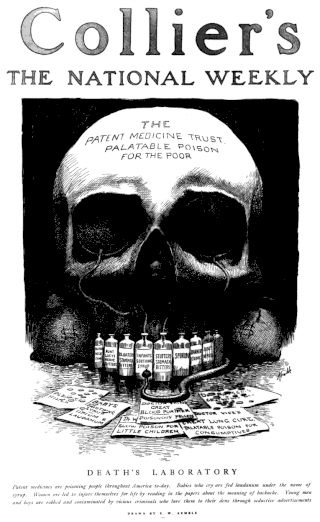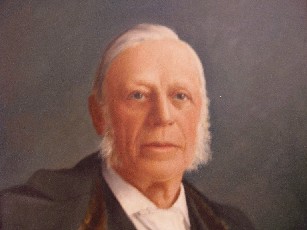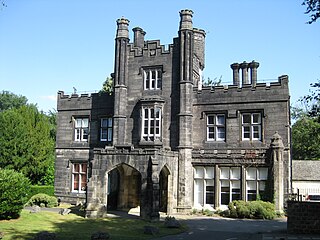
Bausch + Lomb is an eye health products company based in Vaughan, Ontario, Canada. It is one of the world's largest suppliers of contact lenses, lens care products, pharmaceuticals, intraocular lenses, and other eye surgery products. The company was founded in Rochester, New York, in 1853 by optician John Bausch and cabinet maker turned financial backer Henry Lomb. Until its sale in 2013, Bausch + Lomb was one of the oldest continually operating companies in the United States.

Brockville, formerly Elizabethtown, is a city in Eastern Ontario, Canada, in the Thousand Islands region. Although it is the seat of the United Counties of Leeds and Grenville, it is politically independent of the county. It is included with Leeds and Grenville for census purposes only.

A patent medicine is a non-prescription medicine or medicinal preparation that is typically protected and advertised by a trademark and trade name, and claimed to be effective against minor disorders and symptoms, as opposed to an ethical drug that could be obtained only through a pharmacist, usually with a doctor's prescription, and whose composition was openly disclosed. Many over-the-counter medicines were once ethical drugs obtainable only by prescription, and thus are not patent medicines.
A panacea, named after the Greek goddess of universal remedy Panacea, is any supposed remedy that is claimed to cure all diseases and prolong life indefinitely. It was in the past sought by alchemists in connection with the elixir of life and the philosopher's stone, a mythical substance that would enable the transmutation of common metals into gold. Through the 18th and 19th centuries, many "patent medicines" were claimed to be panaceas, and they became very big business. The term "panacea" is used in a negative way to describe the overuse of any one solution to solve many different problems, especially in medicine. The word has acquired connotations of snake oil and quackery.
Almonte is a former mill town in Lanark County, in the eastern portion of Ontario, Canada. Formerly a separate municipality, Almonte is a ward of the town of Mississippi Mills, which was created on January 1, 1998, by the merging of Almonte with Ramsay and Pakenham townships. Almonte is 46 kilometres (29 mi) south-west of downtown Ottawa. Its population as recorded in the 2016 Canadian Census was 5,039.

George Taylor Fulford was a Canadian businessman and politician.

Carter's Little Liver Pills were formulated as a patent medicine by Samuel J. Carter of Erie, Pennsylvania, in 1868.
Chinese patent medicine are herbal medicines in Traditional Chinese medicine, modernized into a ready-to-use form such as tablets, oral solutions or dry suspensions, as opposed to herbs that require cooking.

Dr. Morse's Indian Root Pills was one of the most successful and enduring products to be manufactured and marketed in North America as part of the lucrative patent medicine industry, which thrived during most of the 19th and 20th centuries. Its manufacturer claimed the pills contained herbal ingredients that would help "cleanse the blood," as "impurity of the blood" was believed to be the cause of all disease.

The Beecham Group plc was a British pharmaceutical company. It was once a constituent of the FTSE 100 Index. Beecham, after having merged with American pharmaceutical company SmithKline Beckman to become SmithKline Beecham, merged with Glaxo Wellcome to become GlaxoSmithKline (GSK). GSK still uses the Beechams brand name in the UK for its over-the-counter cold and flu relief products.

William Henry Comstock was an American/Canadian businessman and politician.

The Cangarda is a 126-foot (38 m) long luxury steam yacht that was built in 1901 at the Pusey and Jones shipyard in Wilmington, Delaware. It is the only surviving U.S.-built steel steam yacht and one of only three similar yachts remaining worldwide.

Fulford Place is a historic mansion in Brockville, Ontario. It was completed in 1901 for Senator George Taylor Fulford, a Canadian businessman and politician. The home is now a historic house museum reflecting Edwardian era decorations, and it is operated by the Ontario Heritage Trust. It was designated a National Historic Site of Canada in 1992.
John Morgan Richards, was an American businessman and entrepreneur who made his fortune from the promotion of patent medicines and American cigarettes in Britain. He was the father of the novelist Pearl Mary Teresa Craigie.
The Birthday Honours 2011 for the Commonwealth realms were announced on 11 June 2011 in the United Kingdom, New Zealand, Barbados, Grenada, Papua New Guinea, Solomon Islands, Tuvalu, Saint Lucia, Antigua and Barbuda, and on 13 June 2011 in Australia to celebrate the occasion of the Queen's Official Birthday for 2011.

Bile Beans was a laxative and tonic first marketed in the 1890s. The product supposedly contained substances extracted from a hitherto unknown vegetable source by a fictitious chemist known as Charles Forde. In the early years Bile Beans were marketed as "Charles Forde's Bile Beans for Biliousness", and sales relied heavily on newspaper advertisements. Among other cure-all claims, Bile Beans promised to "disperse unwanted fat" and "purify and enrich the blood".

Frank Harris Fulford was an entrepreneur, art collector and businessman. Born in Canada in 1868, Fulford was educated in Leipzig then he returned to Brockville, a city in Eastern Ontario, where he worked as a dealer in music. He married sometime before 1902 and had three children. An older brother to Charles Edward Fulford, he moved to Leeds, in England, during 1902 to manage the British division of Charles's manufacturing business, C. E. Fulford Limited. The company produced patent medicines, manufacturing products including Bile Beans and Zam-Buk ointment, and was first established in the UK in 1899 after achieving success in Australia. The company undertook an unsuccessful court action, and a later appeal, against an Edinburgh pharmacist in 1905 but it continued to trade and prosper despite the judge opining that the business was "founded on, and conducted by fraud". A year later after the sudden death of his wealthy brother, Charles, Fulford took up the reins of the family business. He purchased Headingley Castle, Leeds, in 1909 and it became the family's main residence.
Funü zazhi was a women's magazine which was in circulation between January 1915 and January 1931 in the Republican period of China and was the longest-running publication in its category during that period.












